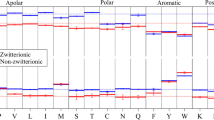Abstract
The collision-induced dissociation spectra of a series of synthetic, tryptic peptides that differed by the position of an internal histidine residue were studied. Electrospray ionization of these peptides produced both doubly and triply protonated molecular ions. Collision-induced fragmentation of the triply protonated peptide ions had better efficiency than that of the doubly protonated ions, producing a higher abundance of product ions at lower collision energies. The product ion spectra of these triply protonated ions were dominated by a series of doubly charged y-ions and the amount of sequence information was dependent on the position of the histidine residue. In the peptides where the histidine was located towards the C-terminus of the peptide, a more extensive series of sequence specific product ions was observed. As the position of the histidine residue was moved towards the N-terminus of the peptide, systematically less sequence information was observed. The peptides were subsequently modified with diethylpyrocarbonate to manipulate the product ion spectra. Addition of the ethoxyformyl group to the N-terminus and histidine residue shifted the predominant charge state of the modified peptide to the doubly protonated form. These peptide ions fragmented efficiently, producing product ion spectra that contained more sequence information than could be obtained from the corresponding unmodified peptide.
Similar content being viewed by others
References
Yates, J. R., 3rd. Mass spectrometry and the age of the proteome. J. Mass Spectrom. 1998, 33, 1–19.
Chambers, G.; Lawrie, L.; Cash, P.; Murray, G. I. Proteomics: A new approach to the study of disease. J. Pathol. 2000, 192, 280–288.
Bichsel, V. E.; Liotta, L. A.; Petricoin, E. F., 3rd. Cancer proteomics: From biomarker discovery to signal pathway profiling. Cancer J. 2001, 7, 69–78.
Fields, S. Proteomics in genomeland. Science 2001, 291, 1221–1224.
Godovac-Zimmermann, J.; Brown, L. R. Perspectives for mass spectrometry and functional proteomics. Mass Spectrom. Rev. 2001, 20, 1–57.
Dongré, A. R.; Jones, J. L.; Somogyi, Á.; Wysocki, V. H. Influence of peptide composition, gas-phase basicity, and chemical modification on fragmentation efficiency: Evidence for the mobile proton model. J. Am. Chem. Soc. 1996, 118, 8365–8374.
Summerfield, S.; Gaskell, S. J. Fragmentation efficiencies of peptide ions following low energy collisional activation. Int. J. Mass Spectrom. Ion Processes 1997, 165/166, 509–521.
Gu, C.; Somogyi, Á.; Wysocki, V. H.; Medzihradszky, D. F. Fragmentation of protonated oligopeptides XLDVLQ (X = L,H,K or R) by surface induced dissociation: Additional evidence for the mobile proton model. Anal. Chem. Acta 1999, 397, 247–256.
Cox, K. A.; Gaskell, S. J.; Morris, M.; Whiting, A. Role of the site of protonation in the low-energy decompositions of gas-phase peptide ions. J. Am. Soc. Mass Spectrom. 1996, 7, 522–531.
Nari, H.; Somogyi, Á.; Wysocki, V. H. Effect of alkyl substitution at the amide nitrogen on amid bond cleavage: Electrospray ionization/surface-induced dissociation fragmentation of substance P and two alkylated analogs. J. Mass Spectrom. 1996, 31, 1141–1148.
Jones, J. L.; Dongré, A. R.; Somogyi, Á.; Wysocki, V. H. Sequence dependence of peptide fragmentation efficiency curves determined by electrospray ionization/surface-induced dissociation mass spectrometry. J. Am. Chem. Soc. 1994, 116, 8368–8369.
Burlet, O.; Orkiszewski, R. S.; Ballard, K.; Gaskell, S. J. Charge promotion of low-energy fragmentations of peptide ions. Rapid Comm. Mass Spectrom. 1992, 6, 658–662.
McCormack, A. L.; Somogyi, Á.; Dongré, A. R.; Wysocki, V. H. Fragmentation of protonated peptides: Surface-induced dissociation in conjunction with a quantum mechanical approach. Analyt. Chem. 1993, 65, 2859–2872.
Wysocki, V. H.; Tsaprailis, G.; Smith, L. L.; Breci, L. A. Mobile and localized protons: A framework for understanding peptide dissociation. J. Mass Spectrom. 2000, 35, 1399–1406.
Kinter, M.; Sherman, N. E. Protein Sequencing and Identification Using Tandem Mass Spectrometry; John Wiley & Sons, Inc: New York, 2000; pp 64–79.
Eng, J. K.; McCormack, A. L.; Yates, J. R., III. An approach to correlate tandem mass spectral data of peptides with amino acid sequences in a protein database. J. Am. Soc. Mass Spectrom. 1994, 5, 976–989.
Perkins, D. N.; Pappin, D. J.; Creasy, D. M.; Cottrell, J. S. Probability-based protein identification by searching sequence databases using mass spectrometry data. Electrophoresis 1999, 20, 3551–3567.
Harrison, A. G. The gas-phase basicities and proton affinities of amino acids and peptides. Mass Spectrom. Rev. 1997, 16, 201–217.
Roth, K. D. W.; Huang, Z. H.; Sadagopan, N.; Watson, J. T. Charge derivatization of peptides for analysis by mass spectrometry. Mass Spectrom. Rev. 1998, 17, 255–274.
Dikler, S.; Kelly, J. W.; Russell, D. H. Improving mass spectrometric sequencing of arginine-containing peptides by derivatization with acetylacetone. J. Mass Spectrom. 1997, 32, 1337–1349.
Brancia, F. L.; Oliver, S. G.; Gaskell, S. J. Improved matrix-assisted laser desorption/ionization mass spectrometric analysis of tryptic hydrolysates of proteins following quanidation of lysine-containing peptides. Rapid Comm. Mass Spectrom. 2000, 14, 2070–2073.
Summerfield, S.; Bolgar, M. S.; Gaskell, S. J. Promotion and stabilization of b1 ions in peptide phenylthiocarbamoyl derivatives: Analogies with condensed-phase chemistry. J. Mass Spectrom. 1997, 32, 225–231.
Miles, E. W. Modification of histidyl residues in proteins by diethylpyrocarbonate. Methods Enzymol. 1977, 47, 431–442.
Author information
Authors and Affiliations
Corresponding author
Rights and permissions
About this article
Cite this article
Willard, B.B., Kinter, M. Effects of the position of internal histidine residues on the collision-induced fragmentation of triply protonated tryptic peptides. J Am Soc Mass Spectrom 12, 1262–1271 (2001). https://doi.org/10.1016/S1044-0305(01)00312-9
Received:
Revised:
Accepted:
Issue Date:
DOI: https://doi.org/10.1016/S1044-0305(01)00312-9




